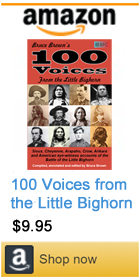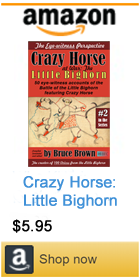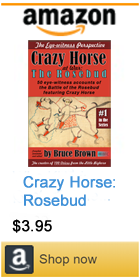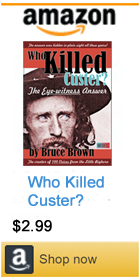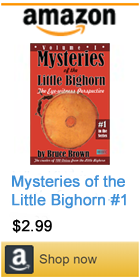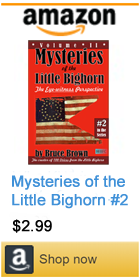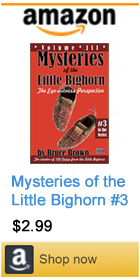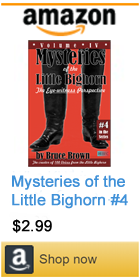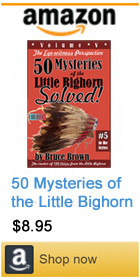|
||||||||||||
Bruce Brown's 100 Voices... White Shield's Story of the Battle
WHITE SHIELD'S STORY
THAT MORNING I went fishing in the Little Bighorn with Black Stone and my nephew. [Note: This was Dives Backward.] My nephew was catching grasshoppers for me. I know nothing about the Reno Fight. The boy sent after grasshoppers came back and said, "An Indian went by wearing a warbonnet -- they must be looking for someone." I got on my horse and rode upon a hill and faintly heard much shooting and saw people running to the hills. I knew that the camp had been attacked. I rode into camp. What I had seen from a distance was the Reno Fight. When I reached camp, all the men were gone, but my mother was leading my war horse around, down in front of the lodge, waiting for me. I bridled my horse and said to my mother, "Where is my war shirt?" She said that a man had just been here who took it to wear in the fight. His name was Bullet Proof. He fixed himself up to fight and tied a [stuffed] kingfisher to his head. While I was dressing myself and telling my mother which way she should go, I looked back and saw soldiers in seven groups (companies). One company could be seen a long way off [because] the horses were pretty white. I turned to go toward Custer, but some Indians had already seen Custer and were going toward him with others from the camps. I went around and came in below, though the company was coming fast, making for the Little Bighorn. Near me I could see only Roan Bear, Bobtail Horse and one other man. [Note: this one other man was probably the Sioux warrior White Cow Bull, who recognized both White Shield and Bobtail Horse at the river.] On my side was a man named Mad Wolf who said, "No one should charge yet the soldiers are too many. Just keep shooting at them." When the Gray Horse Company got pretty close to the river, they dismounted, and all the soldiers back as far as I could see stopped and dismounted also. [Note: this was when Custer rode down the river quickly to scout for another possible crossing point, as witnessed by Peter Thompson, before returning to the ford at Medicine Tail Coulee, trying to cross there, getting shot by White Cow Bull, and dying "in the water of the Little Bighorn." See Who Killed Custer -- The Eye-witness Answer for more info.] When the Gray Horse Company dismounted, the Indians began to fire at them, and the soldiers returned the fire. It was not long before the Indians began to gather in large numbers where I was. After they had been shooting some time, Contrary Big Belly made a charge down in front of the Gray Horse Company and from where the Indians were they saw that the horses of one other company began to get frightened and started to circle around the men who were holding them. When Contrary Big Belly got back, the companies began shooting fast. I looked across the river and saw two men make a charge on another company, far off to the southeast. These two men were Yellow Nose and my half brother. It was here that Yellow Nose got a company flag, snatching it from the ground where it stood and counted coup with it on a soldier. When Yellow Nose turned and went back towards the Indians, the horses of the frightened companies broke away from their holders and stampeded, causing someone to cry out, "The soldiers are coming!" The soldiers holding the horses did not let go; they hung on, but the horses got loose anyway.
Three companies had been killed off before the second three companies and the Gray Horse Company were killed. The three still surviving were half a mile from the Gray Horse Company, toward the hill. Those who survived from the first three companies tried to make their way to the Gray Horse Company, but they did not succeed as all were killed before they got there. Finally, the three surviving companies lost their horses and got up the hill on foot. After the three companies had reached the Gray Horse Company, a man riding a sorrel horse [escaped]. The Gray Horse Company held their horses to the last, and almost all these horses were killed. When the four companies got together, they did not last long. About when the last man dropped in the Gray Horse Company, the Indians made a charge and killed all the wounded with hatchets, arrows, knives etc. Old Bear and Kills in the Night, still living in 1915, chased the man on the sorrel horse, and Old Bear, I think, killed him. The Sioux fired a shot at this soldier but missed. Old Bear then fired, and a little later the soldier fell off his horse, and when they got to him they found he was shot in the back between the shoulders.
White Bull's [AKA Ice Bear's] son, Mad Wolf or Limber Bones, charged among the soldiers and was killed. [Note: here is Wooden Leg's account of Limber Bones' or Noisy Walking's death.] Cheyenne Memories of the Custer Fight: A Source Book by Richard G. Hardorff, The Arthur Clark Co. Spokane, WA 1995, p 49 - 59
The grandson of Whistling Elk and son of Spotted Wolf, White Shield was a reknowned Cheyenne warrior in his own right. Here is Young Two Moon's account of White Shield in action at the Battle of the Rosebud, and specifically saving Young Two Moon's life eight days before the Battle of the Little Bighorn. * * * In his long and distinguished career, George Bird Grinnell was a naturalist with George Custer's 1874 Black Hills expedition, founded of the Audubon Society and was the author of The Fighting Cheyenne. Although not a Cheyenne, or an eye-witness to the battle of the Little Bighorn, George Bird Grinnell shares a crucial quality with the other Sioux, Cheyenne and Crow chroniclers included in 100 Voices. Like Ohiyesa, John Stands In Timber, William Bordeaux, Pretty Shield, Bird Horse and David Humphreys Miller, Grinnell had unique access to important particpants in the Battle of the Little Bighorn. What you see in The Fighting Cheyenne is an intelligent, well-informed and sympathetic telling of the Cheyenne story. Here is Grinnell's chapter on the Battle of the Little Bighorn from The Fighting Cheyenne, and here is his account of Little Horse stripping the corpse of an officer, probably Thomas Custer. -- B.B.
|
||||||||||||



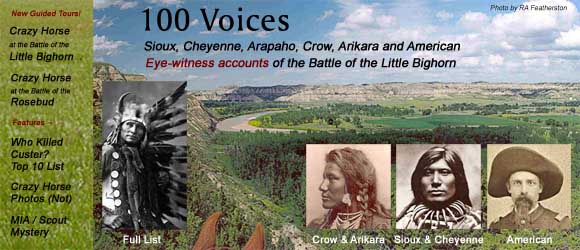
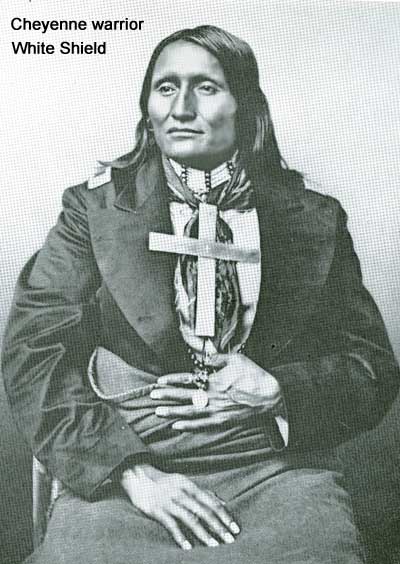 Northern Cheyenne Indian Reservation, Montana, 1908
Northern Cheyenne Indian Reservation, Montana, 1908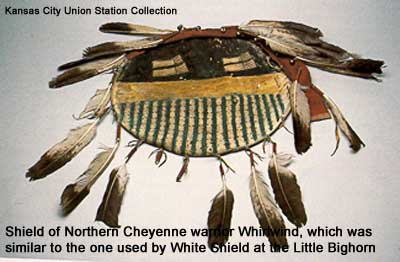
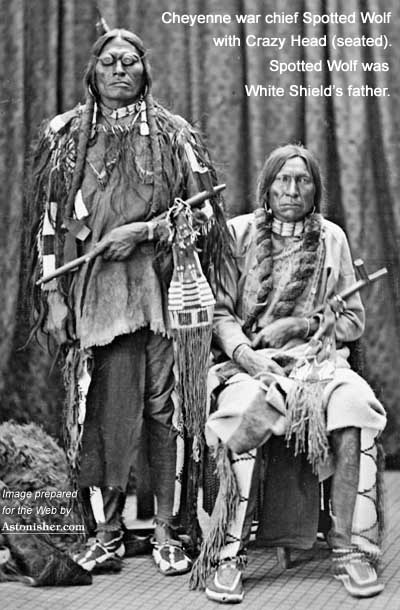 Custer was on the outer edge of the Gray Horse Company, toward the river.
Custer was on the outer edge of the Gray Horse Company, toward the river.